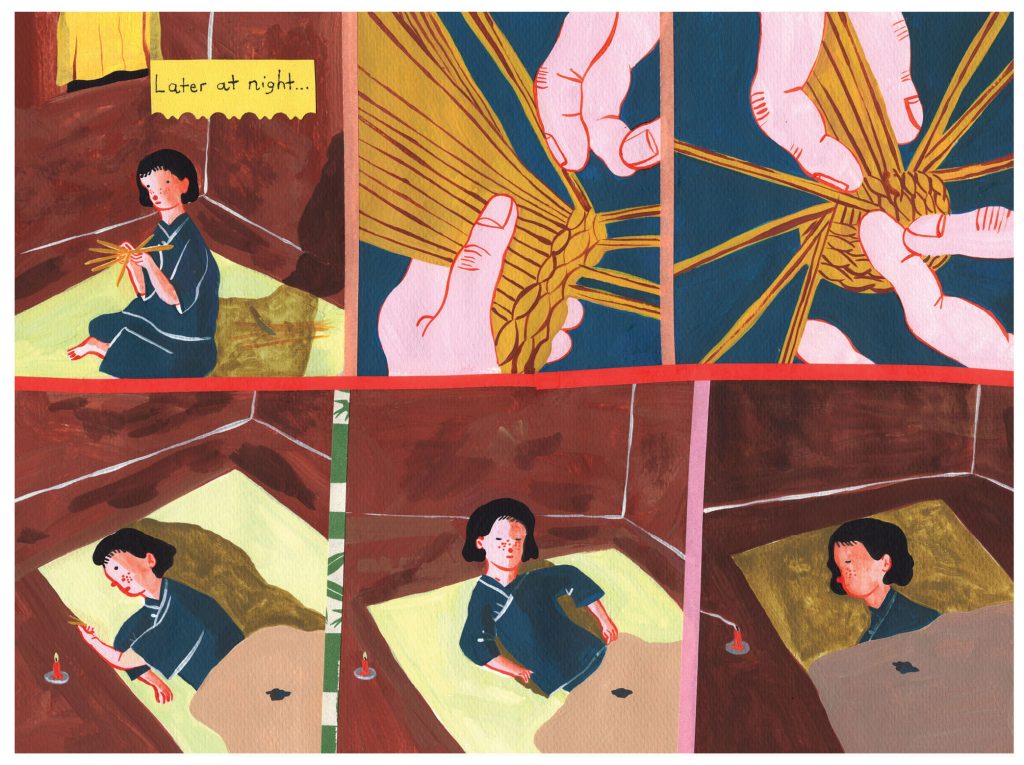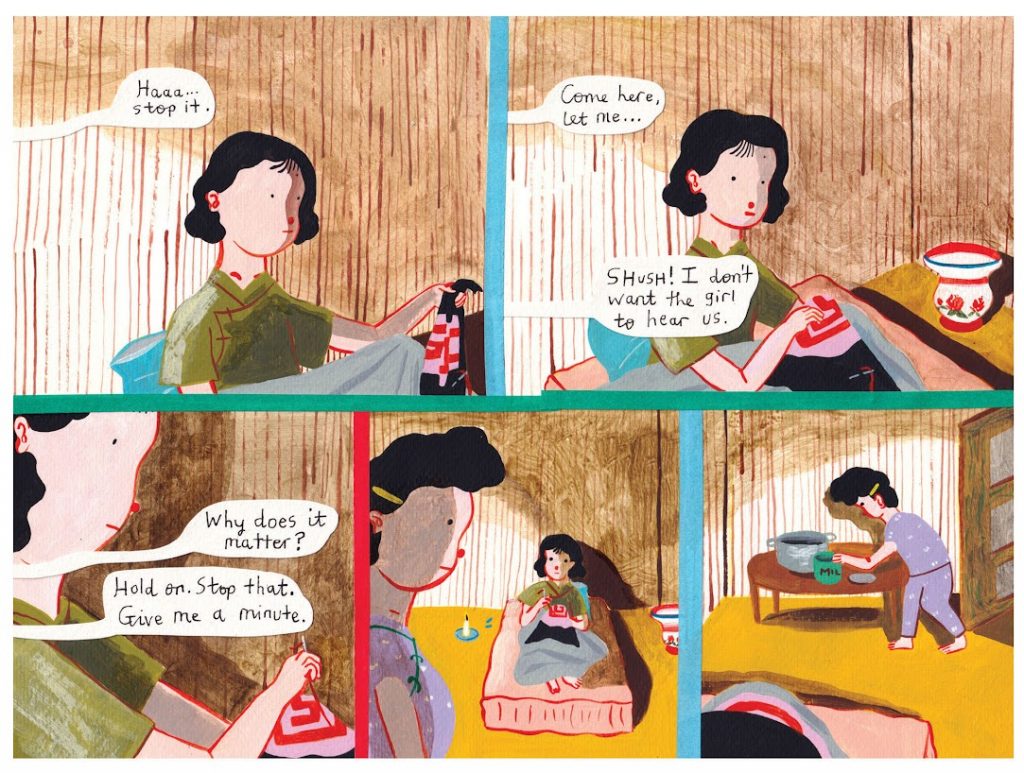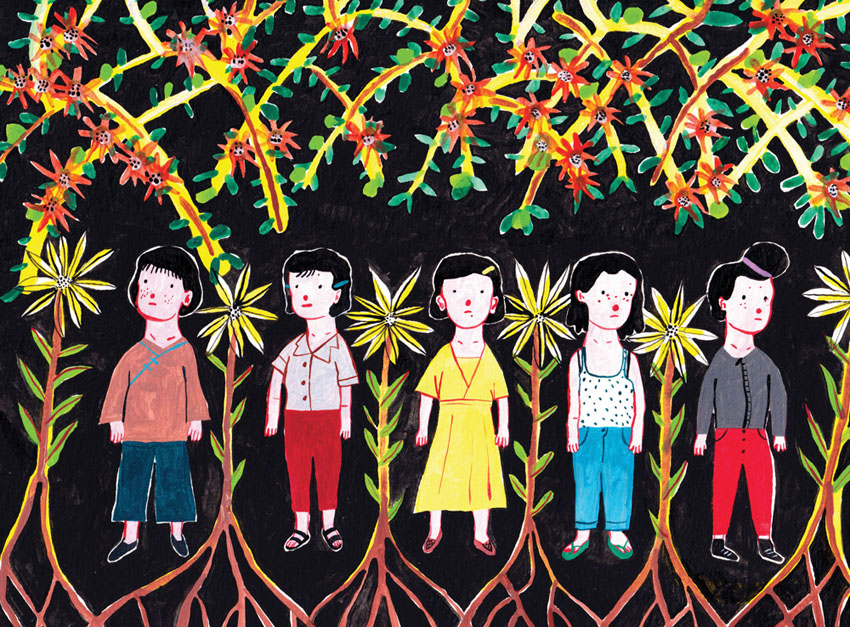Electric Lit is 12 years old! Help support the next dozen years by helping us raise $12,000 for 12 years, and get exclusive merch!
To hear Weng Pixin tell it, Let’s Not Talk Anymore started out as a kind of “fuck you” move after a particularly bad fight with her mom but—as these things tend to go—it gradually transformed into a project to locate herself within the moth-eaten story of her matrilineal line.
Moving back and forth across a 100-year span, the graphic novel depicts snapshots from the lives of five generations of women from Pixin’s family, all aged 15—from her half-mythic great grandmother Kuan, to an imagined daughter in 2032—as they navigate the hostilities within and without the home. The result is a family history riddled with recurring themes: separation, sexual assault, and emotional isolation. Mothers and daughters stewing silent in their anger, each of them hoarding pain like heirlooms for the next generation to inherit.
There’s no telling where things are happening, but the characters are clearly shaped by the cultural and social mores of a traditional Chinese upbringing in Southeast Asia. Though many of these standards have changed over time, the reticence to express true, deep emotions remains. Time and again, these characters resort to anger as their only recourse, unable to cope with the unacknowledged pain sitting within them like a stone.
The novel is deeply invested in the theory that every act of violence—emotional, physical and verbal—has its roots in something undeniably human. In seeking out the truth in the probable lives of her mother and ancestors, Pixin uncovers a road to healing and something that feels a lot like freedom.
Samantha Cheh: I did notice a stark difference in the registers of dialogue in Let’s Not Talk Anymore. On one end of the spectrum, you’d have characters saying very mundane things, like what do you want for breakfast? Let’s go to the field—but then there’s the other side. Characters explode into anger, and language becomes extremely emotional and hurtful. There doesn’t seem to be an in-between mode, no gaps between them.
Weng Pixin: I was particularly thinking about my own experiences growing up with my mother. My dad was away for work a lot of the time, and so she was a primary caregiver. What I remember the most from my upbringing is that when she gets really mad, she doesn’t make a lot of sense: in the words that she used, in what she’s telling me about why she’s mad, in what she’s planning to do. Now, as an adult, I began to realize that I’m working with a mother and a person who has a lot of difficulty trying to explain why she’s upset. If we think carefully about it, that ability to remain calm requires many sets of skills, and I can now see that she had no ability for it.
Those gaps that you describe between these extreme outbursts and the plain language of everyday life—I think those are the conversations, questions and answers that we can ask to get to know each other better. Not to feel what the other person is feeling, but to develop a vocabulary to describe our full human experiences. I think that’s severely lacking in the Chinese Asian parenting culture, and that was what I was perhaps keeping in mind while I was approaching this graphic novel.
SC: I feel like what you’re describing is an ability to process emotions that most of our parents are not equipped with; they can be so reactive. Of course, they came from a very different world, one I am keenly aware is characterized by suffering, but it’s developed in them a kind of eternal survival mode. Tunnel vision. There’s so much emphasis on survival that the quality of life really suffers.
WP: Yes, and I don’t blame them. It just doesn’t make sense to do so when it was a completely different generation, era, and context. There is a scene where Kuan’s mother gives her the porridge, but saves only the porridge water for herself. Later, somebody told me that porridge water has more nutritional content, but the point is it’s not a balance between getting more nutrients or vitamins or energy. It’s “what do I do to survive to the next day”; not “what do I do to live well.”
As a child and teenager, I blamed my mom a lot. I just hated her for just the kind of parent that she was, but through working on this comic, I realized I had never thought about the possible life she came from. I had heard stories, sentences here and there—maybe from her sisters, or whoever is chattier—but not from her because she’s very quiet.
They were just concepts I didn’t really understand, but with comics, you’re thinking in visuals. You have to find a way to put an image down to accompany the concepts. For example, when I was painting my mom missing her dad who left her very abruptly at a young age, I had to ask: What does her dad look like? Would he be sitting very far away from her? What would that be doing while he’s in his daily life? In the process of thinking and putting down those pictures, I got to kind of experience or feel a little more about what it was like to live in her shoes somewhat.

SC: I can imagine her reticence to share those stories must have hurt quite a lot.
WP: I think I understood the hesitation to share more, but it’s also weird because my dad is very chatty. In the family, he’s like the black sheep because he’s so verbal. His communicativeness makes him come off as very forthcoming and straightforward and honest, and because of that, I’ve never felt bothered if he doesn’t tell me something.
I wanted to show how when you carry your own pain, if you don’t give yourself the opportunity to process it—or if you don’t even have the ability to do so—the pain will stay inside of you.
On the other hand, my mom’s uncommunicativeness bothered me because there’s this protectiveness or defensiveness. I read her not talking as not trusting me, or her misreading my questions as invasive when they’re more inquiring. But when I thought about that attitude in relation to where she came from, I realized that what I saw as defensive was maybe a sense of helplessness at my questions.
My dad is so communicative, but even he has difficulty expressing himself—she generally struggles with communicating, so talking about her day-to-day life? Sharing things that seem simple and basic to us? It’s difficult for her. My theory is that she came from an environment that is way more repressive than I can possibly imagine, so talking is a very big challenge for her. In that sense, my questions to her weren’t just, can you tell me this? It was more, can you be this now? Someone that is completely not you? That’s why she reacted with the desire to protect herself because what I was asking of her, she felt like she couldn’t do it.
SC: When you began connecting the dots between your mother and her past and how you were brought up, did it change the day-to-day experience of your relationship with her?
WP: Yes, it definitely did. Halfway through making the comic, I saw that in our in-person interactions, I was a lot less frustrated or reactive because I was putting myself in the space of trying to be in her shoes more. From doing this work and from reading research on her generation or time, I became very aware that she didn’t have a lot of opportunities. She’s been influenced not just by society, but also her mother’s messaging that women have to get married and bear children. If we go a bit further, as a child, she also didn’t have the opportunity to learn how to express herself. Just like what she did to me.
Working on the comic helped me get the barest shape of where she really comes from, and made those ideas a lot more concrete. And once they were concrete, I found that it made no sense to remain angry at her for who she is. All I see now is a person who—with the limit of skill set that she has—came out as this individual. To ask more of her would be irresponsible and selfish on my part, and by the end, the main anger towards her dissipated.
Also physical space apart also helped make the mother-daughter relationship have some opportunity for repair.

SC: Reading the novel, you do get the sense of reparation. With your art, you’re filling in the fissures in the relationship between you and your mother, but also within yourself. I saw some of that with Kuan’s weaving and Mei’s sewing.
WP: For me, art has always helped. With my mom’s upbringing, I was continually discouraged from talking, from expressing myself, from telling her that something is troubling me. It came to a point where I wouldn’t even ask her for advice or anything. I just felt like she was the most unsafe person to consult because I would just end up feeling hurt or disappointed or—even worse—betrayed. For a very long period of time, I was largely a very quiet individual. Not just because I was shy, but mostly because I felt that whatever I say, it’s gonna be wrong—because that’s the lesson I picked up from being with my mom. Everything that I say is met with a very negative outcome. I learned to keep quiet in order to survive.
With my art, I was able to process a lot of things that I felt I didn’t dare do with words. It’s been healing in a sense of just being able to let something out. It sounds disgusting, but it’s just like diarrhea. Like mental, spiritual diarrhea. Art provided that lovely toilet bowl for me to share the love. [laughs]
SC: There are a lot of like images that recur for me in the comic, motifs like absent fathers, sexual predation, separation, and weaving. Certain scenes clearly speak to each other across time
WP: I was trying to show how trauma gets passed along and affects the way we relate to another human being—and how that can get even more pronounced when this relation is between a parent to a child. For example, Mei, my maternal grandmother, is sexually assaulted and she deals with this trauma privately because she just had no space to tell it to anybody in this society, not even her adoptive mother. To make it more confusing, her adoptive mother treats her like slave labor but also takes care of her. It’s a very strange message for somebody to grow up with: the person that provides for you essentially doesn’t care about your well-being, but you have to trust and rely on them.
I learned to keep quiet in order to survive. With my art, I was able to process a lot of things that I felt I didn’t dare do with words.
The thing to remember is that these characters are adolescents, and what adolescent has the amazing ability to differentiate how much to trust someone or pull back, all while still needing them to survive? That’s why, with that kind of upbringing, I felt it was possible that she can then find somebody, get married, and then unconsciously reenact that same pain and trauma on her children because she’s just unaware of how much they have taken over her.
I really wanted to show how the minute you carry your own pain, if you don’t give yourself the opportunity to process it—or if you don’t even have the ability to do so—the pain will stay inside of you. And whoever that you meet next will get it in some way from your lack of ability to attend to them, because you haven’t attended to yourself.
SC: The funny thing about getting older is that you can now recognize all the ways your needs weren’t met, all the gaps that were left by the adults in your life. If you could go back, would you?
WP: I think that question is interesting because on the one hand, I would definitely always say yes. Would I have benefited if I had a parent who was attuned to my needs? Of course, yes. It wouldn’t make crying feel shameful, it wouldn’t make feeling some things or encountering some experiences outside of home feel weird or scary.
The thing I’ve always struggled with is what my art would have been like. Would I have content? Would it have been interesting? Would the non-pain and non-challenge have yielded something interesting, art-wise? That’s the part I have no idea how to answer. I hope so, but the reality is that my art has been derived from challenges, pain. Things that confused me, things that have upset me. I’ve always been provided for physically, but I think it’s more the emotional landscape of myself that has been a big struggle to make sense of. I wish I could say that my talent and skill would have yielded art that was just as good, but I cannot claim that.

SC: Actually, at times, reading the novel was a little bit difficult because there was not always a lot of distinction between characters. They look and often feel very similar.
WP: It was just as confusing in my head, and there was no interest to get them to look distinct. Partly because of the cartoony style, but I remember kind of thinking I don’t really need them to be so distinctive. I kind of want it messy and confusing. The only structure the reader can grasp onto is the year that’s been written down because that’s just the way my mind was. I have no picture of how my great grandmother looks, of her living space. I have no visual. There’s still tons of missing things. I imagine for most people, when you’re trying to recollect a memory, it’s visual; it’s experience, it’s the feeling. All that is missing because there’s no stories.
SC: I love that by imagining the shape of Kuan’s possible life, you’ve kind of woven for yourself a sense of continuity that you didn’t have because of all those gaps in your history. Now with this complete work, is that emphasis on remembering still important for you? Why?
WP: Why do we need to know our history? Why do we need to know the past? In one sense, it’s to help give you a stronger sense of where you’re from, and the kind of values or belief system that you come from. Not that you in the present necessarily need to follow, but you just have a better understanding of your origins—and I don’t, from my mom’s side of the family. I don’t have a great grasp of where I come from, in that sense.
I can tell you from my dad’s side that I know that my paternal grandmother was really into business, and she had a father who was an opium addict. She was from Hong Kong, and that immediately made me feel I have kinship with this country even though I don’t live there. It sounds kind of corny and cheesy, but it’s almost like, oh this is a connection there, it didn’t come out of nowhere. It also shapes a bit of how we look at our future.
In knowing our history we find out more about ourselves. I know my art comes from my maternal side because all my aunties painted before they got married. My mom still draws when she’s on phone calls, but the sad thing is that she dismisses herself. When I was a kid, I visited my maternal grandmother’s house and I saw the paintings that each aunt did, as well as my mom, so that came from them. That’s why I made up the story that my great grandmother loved to basket-weave when she was free, and my grandmother loves to sew. I just imagined I came from this line of women who made art in private and nobody sees it.

